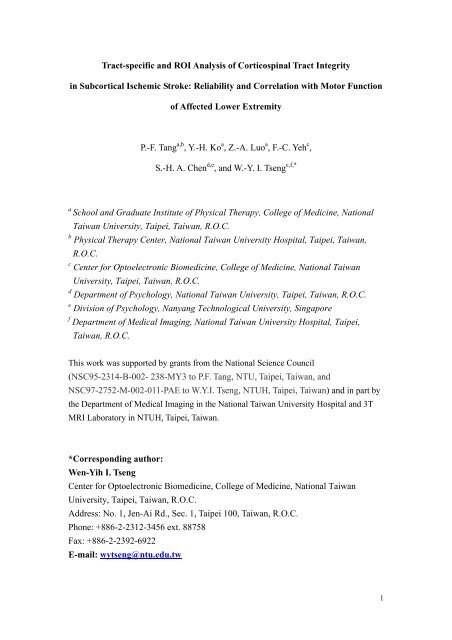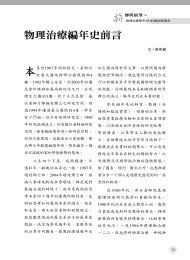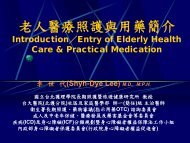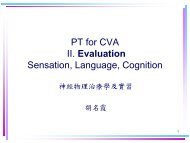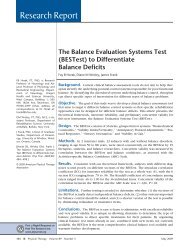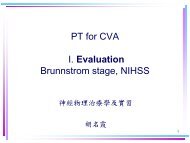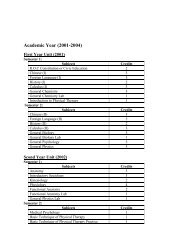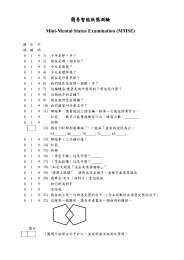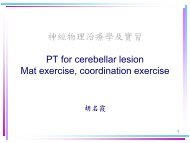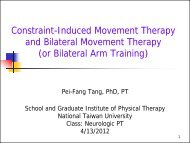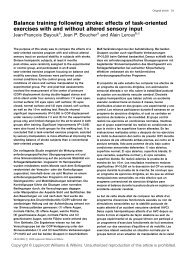Tract-specific and ROI Analysis of Corticospinal Tract Integrity in ...
Tract-specific and ROI Analysis of Corticospinal Tract Integrity in ...
Tract-specific and ROI Analysis of Corticospinal Tract Integrity in ...
You also want an ePaper? Increase the reach of your titles
YUMPU automatically turns print PDFs into web optimized ePapers that Google loves.
<strong>Tract</strong>-<strong>specific</strong> <strong>and</strong> <strong>ROI</strong> <strong>Analysis</strong> <strong>of</strong> <strong>Corticosp<strong>in</strong>al</strong> <strong>Tract</strong> <strong>Integrity</strong><br />
<strong>in</strong> Subcortical Ischemic Stroke: Reliability <strong>and</strong> Correlation with Motor Function<br />
<strong>of</strong> Affected Lower Extremity<br />
P.-F. Tang a,b , Y.-H. Ko a , Z.-A. Luo a , F.-C. Yeh c ,<br />
S.-H. A. Chen d,e , <strong>and</strong> W.-Y. I. Tseng c,f,*<br />
a<br />
School <strong>and</strong> Graduate Institute <strong>of</strong> Physical Therapy, College <strong>of</strong> Medic<strong>in</strong>e, National<br />
Taiwan University, Taipei, Taiwan, R.O.C.<br />
b Physical Therapy Center, National Taiwan University Hospital, Taipei, Taiwan,<br />
R.O.C.<br />
c Center for Optoelectronic Biomedic<strong>in</strong>e, College <strong>of</strong> Medic<strong>in</strong>e, National Taiwan<br />
University, Taipei, Taiwan, R.O.C.<br />
d Department <strong>of</strong> Psychology, National Taiwan University, Taipei, Taiwan, R.O.C.<br />
e Division <strong>of</strong> Psychology, Nanyang Technological University, S<strong>in</strong>gapore<br />
f Department <strong>of</strong> Medical Imag<strong>in</strong>g, National Taiwan University Hospital, Taipei,<br />
Taiwan, R.O.C.<br />
This work was supported by grants from the National Science Council<br />
(NSC95-2314-B-002- 238-MY3 to P.F. Tang, NTU, Taipei, Taiwan, <strong>and</strong><br />
NSC97-2752-M-002-011-PAE to W.Y.I. Tseng, NTUH, Taipei, Taiwan) <strong>and</strong> <strong>in</strong> part by<br />
the Department <strong>of</strong> Medical Imag<strong>in</strong>g <strong>in</strong> the National Taiwan University Hospital <strong>and</strong> 3T<br />
MRI Laboratory <strong>in</strong> NTUH, Taipei, Taiwan.<br />
*Correspond<strong>in</strong>g author:<br />
Wen-Yih I. Tseng<br />
Center for Optoelectronic Biomedic<strong>in</strong>e, College <strong>of</strong> Medic<strong>in</strong>e, National Taiwan<br />
University, Taipei, Taiwan, R.O.C.<br />
Address: No. 1, Jen-Ai Rd., Sec. 1, Taipei 100, Taiwan, R.O.C.<br />
Phone: +886-2-2312-3456 ext. 88758<br />
Fax: +886-2-2392-6922<br />
E-mail: wytseng@ntu.edu.tw<br />
1
Abstract<br />
BACKGROUND AND PURPOSE: <strong>Tract</strong>-<strong>specific</strong> (TS) analysis has been suggested<br />
as a useful method to evaluate the fiber <strong>in</strong>tegrity <strong>of</strong> white matter tracts. This study<br />
<strong>in</strong>vestigated the <strong>in</strong>tra-rater <strong>and</strong> <strong>in</strong>ter-rater reliability <strong>and</strong> validity <strong>of</strong> a TS analysis for<br />
the corticosp<strong>in</strong>al tract (CST) <strong>and</strong> compared the results with those <strong>of</strong> a<br />
region-<strong>of</strong>-<strong>in</strong>terest (<strong>ROI</strong>)-based analysis.<br />
MATERIALS AND METHODS: Diffusion spectrum imag<strong>in</strong>g was performed on<br />
seven patients with subcortical ischemic stroke on a 3T MRI system. For the TS<br />
analysis, seed regions were placed at the cerebral peduncle <strong>and</strong> the medial portion <strong>of</strong><br />
the primary motor cortex to reconstruct the tracts <strong>of</strong> the CST for motor control <strong>of</strong> the<br />
lower extremity. The mean generalized fractional anisotropy (GFA) was measured at<br />
the posterior limb <strong>of</strong> the <strong>in</strong>ternal capsule (PLIC) (GFA PLIC-TS ) by calculat<strong>in</strong>g the<br />
weighted sum <strong>of</strong> the GFAs sampled by the CST tracts at this segment. For the<br />
<strong>ROI</strong>-based analysis, the posterior two-thirds <strong>of</strong> the PLIC were enclosed on the GFA<br />
maps, <strong>and</strong> the mean GFA <strong>in</strong> this <strong>ROI</strong> was calculated (GFA PLIC-<strong>ROI</strong> ).<br />
RESULTS: The results showed good-to-excellent <strong>in</strong>tra-rater <strong>and</strong> <strong>in</strong>ter-rater reliability<br />
on the seed region/<strong>ROI</strong> placement (mean Kappa values >0.80) <strong>and</strong> mean GFA values<br />
(ICCs >0.90) for both the TS <strong>and</strong> <strong>ROI</strong>-based analyses. Both the GFA PLIC-TS <strong>and</strong><br />
GFA PLIC-<strong>ROI</strong> values were highly correlated with the motor function <strong>of</strong> the affected<br />
2
lower extremity (r=0.76 <strong>and</strong> 0.80, respectively, p
Abbreviation Keys:<br />
BG= basal ganglia; CP= cerebral peduncle; CST= corticosp<strong>in</strong>al tract; DSI= diffusion<br />
spectrum imag<strong>in</strong>g; DTI= diffusion tensor imag<strong>in</strong>g; FA= fractional anisotropy;<br />
FMA-LE = Fugl-Meyer Assessment <strong>of</strong> lower extremity; GFA= generalized fractional<br />
anisotropy; GFA PLIC-TS = GFA value <strong>of</strong> the PLIC calculated by us<strong>in</strong>g the tract-<strong>specific</strong><br />
method; GFA PLIC-<strong>ROI</strong> = GFA value <strong>of</strong> the PLIC calculated by us<strong>in</strong>g the <strong>ROI</strong>-based<br />
method; ICC= <strong>in</strong>traclass correlation coefficients; M1= primary motor<br />
cortex/precentral gyrus; PLIC = the posterior limb <strong>of</strong> the <strong>in</strong>ternal capsule; <strong>ROI</strong>=<br />
region-<strong>of</strong>-<strong>in</strong>terest; TS= tract-<strong>specific</strong>.<br />
4
Introduction<br />
Us<strong>in</strong>g MR diffusion tensor imag<strong>in</strong>g (DTI) to assess the <strong>in</strong>tegrity <strong>of</strong> white matter<br />
tracts <strong>in</strong> patients with stroke is potentially valuable to correlate the motor impairments<br />
<strong>and</strong> to predict functional outcomes. 1,2 It has been reported that fractional anisotropy<br />
(FA), which is a quantitative <strong>in</strong>dex <strong>of</strong> the directional anisotropy <strong>of</strong> water molecular<br />
diffusion derived from the diffusion tensor, is an effective measure <strong>of</strong> fiber <strong>in</strong>tegrity. 3<br />
Decreases <strong>in</strong> FA have been found <strong>in</strong> the affected tracts at <strong>in</strong>farct regions <strong>and</strong> regions<br />
with Wallerian degeneration. 1,4,5 Knowledge about tract <strong>in</strong>tegrity after stroke may<br />
allow for both the accurate stratification <strong>of</strong> functional recovery <strong>and</strong> the plann<strong>in</strong>g <strong>of</strong><br />
effective customized rehabilitation programs for <strong>in</strong>dividual patients.<br />
Most studies have used region-<strong>of</strong>-<strong>in</strong>terest (<strong>ROI</strong>) based analysis <strong>of</strong> FA maps to<br />
detect white matter changes <strong>in</strong> patients with stroke. 2,6,7 Us<strong>in</strong>g <strong>ROI</strong>-based analysis,<br />
researchers manually select certa<strong>in</strong> white matter regions with the aid <strong>of</strong> anatomical<br />
l<strong>and</strong>marks. This approach depends on raters’ familiarity with the bra<strong>in</strong> anatomy <strong>and</strong> is<br />
thus subject to poor <strong>in</strong>ter-rater <strong>and</strong> <strong>in</strong>tra-rater reproducibility. 8<br />
Recently, several<br />
studies have suggested that tract-<strong>specific</strong> (TS) analysis may be more objective,<br />
<strong>specific</strong>, 9-11 <strong>and</strong> reliable 11,12 than <strong>ROI</strong>-based analysis to evaluate the <strong>in</strong>tegrity <strong>of</strong> white<br />
matter fibers. The TS analysis method uses diffusion tractography as a guide to<br />
quantify the FA <strong>of</strong> a <strong>specific</strong> fiber tract bundle. 9, 11, 13-16 Compared to <strong>ROI</strong>-based<br />
5
analysis, TS analysis has the advantage <strong>of</strong> explor<strong>in</strong>g the fiber <strong>in</strong>tegrity anywhere<br />
along a tract <strong>of</strong> <strong>in</strong>terest, <strong>and</strong> thus, it is not limited to regions identifiable by anatomical<br />
l<strong>and</strong>marks.<br />
Perform<strong>in</strong>g tractography <strong>of</strong> a long tract bundle such as the corticosp<strong>in</strong>al tract<br />
(CST) <strong>of</strong>ten encounters <strong>in</strong>terruption <strong>of</strong> the tracts <strong>in</strong> patients with stroke. 17-19 This is<br />
because the FA values tend to decrease, <strong>and</strong> the tensor orientations become<br />
disorganized <strong>in</strong> the <strong>in</strong>farct location <strong>and</strong> its surround<strong>in</strong>gs. The track<strong>in</strong>g procedure <strong>of</strong><br />
the tractography algorithm would come to a halt when the FA value or proceed<strong>in</strong>g<br />
angle does not pass a default threshold. Even if the tractography is not <strong>in</strong>terrupted, it<br />
is still difficult to obta<strong>in</strong> a m<strong>in</strong>or branch <strong>of</strong> a tract bundle from the tractography<br />
because the tensor orientation is predom<strong>in</strong>antly po<strong>in</strong>t<strong>in</strong>g toward the orientation <strong>of</strong> the<br />
major branches. <strong>Analysis</strong> <strong>of</strong> our unpublished laboratory data supported that these<br />
difficulties pose a great challenge to TS analysis <strong>of</strong> the CST if a m<strong>in</strong>or branch, such as<br />
that correspond<strong>in</strong>g to the lower extremity motor control orig<strong>in</strong>ated from the primary<br />
motor cortex (M1), is to be assessed. In this study, we used diffusion spectrum<br />
imag<strong>in</strong>g (DSI) to address these problems. 20,21 DSI entails the acquisition <strong>of</strong> more than<br />
200 diffusion-weighted images over the whole bra<strong>in</strong>, where each diffusion weight<strong>in</strong>g<br />
corresponds to a <strong>specific</strong> encod<strong>in</strong>g po<strong>in</strong>t <strong>in</strong> the q-space. DSI tractography has been<br />
demonstrated to differentiate the CST from other cross<strong>in</strong>g fiber tracts, <strong>in</strong>clud<strong>in</strong>g the<br />
6
corpus callosum, superior longitud<strong>in</strong>al fasciculus, <strong>and</strong> middle cerebellar peduncle, <strong>and</strong><br />
it has been shown to separate the branches aris<strong>in</strong>g from different cortical areas<br />
responsible for the movement <strong>of</strong> different body parts. 22,23<br />
Previous studies have <strong>in</strong>vestigated the reproducibility <strong>of</strong> TS analysis <strong>in</strong> patients<br />
with amyotrophic lateral sclerosis <strong>and</strong> <strong>in</strong> premature <strong>in</strong>fants. 9,11 The same studies <strong>in</strong><br />
patients with stroke are still lack<strong>in</strong>g. Although there have been many studies us<strong>in</strong>g<br />
<strong>ROI</strong>-based analysis to reveal the correlation between the FA <strong>and</strong> motor function <strong>in</strong><br />
patients with stroke, 1,2,4,24,25<br />
such functional correlation studies us<strong>in</strong>g the TS<br />
quantitative analysis have not yet been established. As for diffusion tensor<br />
tractography, only a qualitative analysis <strong>of</strong> the CST has been performed to relate the<br />
17-19, 26,27<br />
degrees <strong>of</strong> tract <strong>in</strong>terruption <strong>and</strong> functional outcomes.<br />
Therefore, the goal <strong>of</strong> this study was to establish the reliability <strong>and</strong> validity <strong>of</strong> the<br />
TS analysis method. We acquired DSI data from patients with subcortical ischemic<br />
stroke, reconstructed the whole CST orig<strong>in</strong>at<strong>in</strong>g from the M1 region correspond<strong>in</strong>g to<br />
the lower extremity motor control, <strong>and</strong> quantified the generalized fractional<br />
anisotropy (GFA) at the segments cover<strong>in</strong>g the posterior limb <strong>of</strong> the <strong>in</strong>ternal capsule<br />
(PLIC). The purpose <strong>of</strong> this study was tw<strong>of</strong>old. First, we <strong>in</strong>vestigated the reliability <strong>of</strong><br />
TS analysis <strong>of</strong> the CST or, more <strong>specific</strong>ally, the <strong>in</strong>tra-rater <strong>and</strong> <strong>in</strong>ter-rater reliability<br />
<strong>of</strong> the GFA values. Second, we tested the validity <strong>of</strong> the TS analysis by correlat<strong>in</strong>g the<br />
7
GFA values with the cl<strong>in</strong>ical motor function scores <strong>of</strong> the affected lower limbs. In this<br />
study, the performance <strong>of</strong> the <strong>ROI</strong>-based analysis was also evaluated <strong>and</strong> compared<br />
with the TS analysis.<br />
8
Materials <strong>and</strong> Methods<br />
Subjects<br />
Patients with stroke were recruited from the stroke registry <strong>of</strong> the Neurology<br />
Department at the National Taiwan University Hospital. The <strong>in</strong>clusion criteria <strong>of</strong> the<br />
patients to participate <strong>in</strong> this research were the follow<strong>in</strong>g: (1) hav<strong>in</strong>g first-ever<br />
ischemic stroke based on cl<strong>in</strong>ical imag<strong>in</strong>g reports <strong>and</strong> physician diagnosis; (2)<br />
present<strong>in</strong>g subcortical stroke with unilateral hemiplegia or hemiparesis; (3) show<strong>in</strong>g<br />
mild-to-moderate severity <strong>of</strong> stroke, correspond<strong>in</strong>g to the National Institutes <strong>of</strong> Health<br />
Stroke Scale ≤ 15; 28 (4) be<strong>in</strong>g between 40 <strong>and</strong> 80 years old; <strong>and</strong> (5) hav<strong>in</strong>g no<br />
contra<strong>in</strong>dications for MR scann<strong>in</strong>g, such as an electrical device implanted <strong>in</strong> the body<br />
or claustrophobia. Patients were excluded if they had cortical stroke, unstable medical<br />
conditions, impaired cognitive function, or were unable to communicate. All<br />
participants signed an <strong>in</strong>formed consent form approved by the <strong>in</strong>stitutional review<br />
board.<br />
We evaluated the function <strong>of</strong> cognition with the M<strong>in</strong>i-Mental State Exam<strong>in</strong>ation. 29<br />
Impairment <strong>in</strong> sensation, range <strong>of</strong> motion, <strong>and</strong> motor function <strong>of</strong> the affected lower<br />
extremity were evaluated us<strong>in</strong>g the Fugl-Meyer Assessment (FMA-LE). 30 We used<br />
Manual Muscle Test<strong>in</strong>g 31 to check whether there was any muscle weakness <strong>of</strong> the<br />
unaffected lower extremity. The reliability <strong>and</strong> validity <strong>of</strong> these cl<strong>in</strong>ical assessments<br />
9
have been established. 32-34<br />
Seven patients with subcortical ischemic stroke participated <strong>in</strong> this study (four<br />
men <strong>and</strong> three women; mean age = 59.2 ± 7.9 years; five with right subcortical lesions<br />
<strong>and</strong> two with left subcortical lesions). The seven subjects were all right-h<strong>and</strong>ed <strong>and</strong><br />
right-footed before their stroke episode. All <strong>of</strong> them showed early ( with<strong>in</strong> 3 days <strong>of</strong><br />
onset) National Institutes <strong>of</strong> Health Stroke Scale scores rang<strong>in</strong>g from 2 to 8, <strong>in</strong>dicat<strong>in</strong>g<br />
mild to moderate stroke <strong>in</strong> the acute stage (Table 1). All patients had normal cognitive<br />
function (M<strong>in</strong>i-Mental State Exam<strong>in</strong>ation > 24, out <strong>of</strong> a total <strong>of</strong> 30) <strong>and</strong> <strong>in</strong>tact sensory<br />
function <strong>of</strong> the affected lower extremities (FMA-LE sensory score = 24, out <strong>of</strong> a total<br />
<strong>of</strong> 24). One participant had moderate range <strong>of</strong> motion limitation at the hip <strong>and</strong> ankle<br />
jo<strong>in</strong>ts <strong>of</strong> the affected lower extremity. The FMA-LE motor score <strong>of</strong> the affected lower<br />
extremities <strong>of</strong> the subjects ranged from 12 to 34 (out <strong>of</strong> a total <strong>of</strong> 34), <strong>in</strong>dicat<strong>in</strong>g mild<br />
to moderate residual motor impairment (Table 1). All <strong>of</strong> the patients underwent MRI<br />
scann<strong>in</strong>g approximately 90 days (93.6 ± 5.9 days) after stroke onset.<br />
MR Data Acquisition<br />
Patients were scanned on a 3T MRI system (TRIO, Siemens MAGNETOM,<br />
Germany) with an eight-channel phased-array head coil. Head movement was<br />
restricted with exp<strong>and</strong>able foam cushions. An axial plane parallel to the anterior<br />
10
commissure - posterior commissure l<strong>in</strong>e was determ<strong>in</strong>ed for the slice orientation <strong>of</strong><br />
both the subsequent structural MRI <strong>and</strong> the DSI scans. To provide an anatomical<br />
reference, a T2 weighted fast sp<strong>in</strong> echo sequence was performed with 35 contiguous<br />
axial slices cover<strong>in</strong>g the whole bra<strong>in</strong> (TR / TE = 5290 /102 ms, flip angle = 150°, field<br />
<strong>of</strong> view = 250 x 250 mm 2 , matrix = 256 × 256, slice thickness = 3.9 mm). The DSI<br />
data were acquired us<strong>in</strong>g a pulsed gradient twice-refocused sp<strong>in</strong>-echo echo-planar<br />
imag<strong>in</strong>g sequence. 35 In this study, 203 diffusion gradient vectors were applied, each<br />
correspond<strong>in</strong>g to one <strong>of</strong> the isotropic 3D grid po<strong>in</strong>ts <strong>in</strong> the q-space. 36 The maximum<br />
diffusion gradient was equivalent to the maximum diffusion sensitivity (b max ) <strong>of</strong> 6000<br />
s/mm 2 . The DSI data were obta<strong>in</strong>ed at 2.9 3 mm 3 isotropic resolution (TR / TE = 9100<br />
/ 142 ms, flip angle = 90°, field <strong>of</strong> view = 370 x 370 mm 2 , matrix = 128 × 128, slice<br />
thickness = 2.9 mm). As a result, a total <strong>of</strong> 203 diffusion-weighted bra<strong>in</strong> volumes<br />
were acquired, where each volume consisted <strong>of</strong> forty-five trans-axial slices<br />
encompass<strong>in</strong>g the whole bra<strong>in</strong>. We used a st<strong>and</strong>ard procedure to stabilize the head <strong>and</strong><br />
body <strong>of</strong> the participants dur<strong>in</strong>g the scann<strong>in</strong>g to m<strong>in</strong>imize the problem <strong>of</strong> head motion.<br />
The total scan time was approximately 45 m<strong>in</strong>utes for each participant. All<br />
participants were able to tolerate the whole scann<strong>in</strong>g section.<br />
11
MR Data <strong>Analysis</strong><br />
Two raters who are licensed physical therapists specialized <strong>in</strong> neurologic physical<br />
therapy <strong>and</strong> had had two years <strong>of</strong> <strong>in</strong>tensive tra<strong>in</strong><strong>in</strong>g on MR data acquisition <strong>and</strong><br />
analysis, ZAL <strong>and</strong> YHK, were first tra<strong>in</strong>ed by the set <strong>of</strong> analysis guidel<strong>in</strong>es described<br />
below. The relatively fair spatial resolution <strong>of</strong> the GFA maps on which the seed<br />
region/<strong>ROI</strong> areas were selected may also affect the reliability <strong>of</strong> the seed region/<strong>ROI</strong><br />
placement. To ameliorate this potential problem, the raters used the subjects’ T2<br />
weighted structure images to guide the identification <strong>of</strong> anatomical l<strong>and</strong>marks on the<br />
GFA maps.<br />
<strong>Tract</strong>-<strong>specific</strong> (TS) Quantitative <strong>Analysis</strong><br />
Hav<strong>in</strong>g acquired the DSI data, the probability density function at each pixel was<br />
reconstructed by perform<strong>in</strong>g a Fourier transform <strong>of</strong> the signal <strong>in</strong>tensity <strong>in</strong> the q-space.<br />
The orientation distribution function was then calculated us<strong>in</strong>g the second moments <strong>of</strong><br />
the probability density function <strong>in</strong> different radial directions. 20 The GFA, 37 a<br />
quantitative <strong>in</strong>dex derived from the orientation distribution function to <strong>in</strong>dicate<br />
diffusion anisotropy, was calculated at each pixel. The fiber vectors at each pixel were<br />
also def<strong>in</strong>ed by select<strong>in</strong>g the peak orientations <strong>of</strong> the orientation distribution<br />
function. 23<br />
12
The reconstruction <strong>of</strong> the CST tractography was performed by a modified<br />
streaml<strong>in</strong>e method 22 us<strong>in</strong>g the <strong>in</strong>-house s<strong>of</strong>tware DSI Studio (http://sites.google.com<br />
/a/labsolver.org/dsi-studio/). The seed po<strong>in</strong>ts for <strong>in</strong>itiat<strong>in</strong>g the fiber track<strong>in</strong>g were<br />
placed at two seed regions: the cerebral peduncle (CP) at the midbra<strong>in</strong> level (Fig. 1a)<br />
<strong>and</strong> the medial part <strong>of</strong> the precentral gyrus (M1) (Fig. 1b). The CST correspond<strong>in</strong>g to<br />
motor control <strong>of</strong> the lower extremity was obta<strong>in</strong>ed by track<strong>in</strong>g through the two seed<br />
regions. The selection <strong>of</strong> the seed region at the CP was outl<strong>in</strong>ed by choos<strong>in</strong>g the two<br />
slices conta<strong>in</strong><strong>in</strong>g the CP at the midbra<strong>in</strong> <strong>and</strong> then enclos<strong>in</strong>g the pixels conta<strong>in</strong><strong>in</strong>g the<br />
CP area. The seed region at the lower extremity region <strong>of</strong> the precentral gyrus was<br />
def<strong>in</strong>ed as follows. First, from the vertex downward, we selected the first four slices<br />
that allowed clear identification <strong>of</strong> the precentral sulcus, precentral gyrus, central<br />
sulcus, <strong>and</strong> postcentral gyrus. Second, we encompassed the region correspond<strong>in</strong>g to<br />
motor control <strong>of</strong> the lower extremity <strong>in</strong> the precentral gyrus. The seed region that was<br />
thereby def<strong>in</strong>ed usually spanned four columns <strong>of</strong> pixels on each bank <strong>of</strong> the medial<br />
longitud<strong>in</strong>al fissure, <strong>and</strong> the seed region was typically located between the precentral<br />
sulcus <strong>and</strong> central sulcus. To determ<strong>in</strong>e the propagat<strong>in</strong>g direction <strong>of</strong> a fiber vector <strong>in</strong><br />
the seed region, tril<strong>in</strong>ear <strong>in</strong>terpolation was applied on the fiber orientations <strong>of</strong><br />
neighbor<strong>in</strong>g voxels at the 8 corners. If voxels conta<strong>in</strong>ed multiple fiber orientations,<br />
the orientation closest to the previous propagat<strong>in</strong>g direction was selected for<br />
13
<strong>in</strong>terpolation. The next po<strong>in</strong>t <strong>of</strong> the fiber tract was determ<strong>in</strong>ed by the propagat<strong>in</strong>g<br />
direction. The procedures were performed recursively <strong>and</strong> term<strong>in</strong>ated when the<br />
turn<strong>in</strong>g angle exceeded a <strong>specific</strong> threshold, 32°, or when the tract reached a voxel<br />
without fibers. Us<strong>in</strong>g this method, the fiber tracts pass<strong>in</strong>g through both seed regions<br />
were reta<strong>in</strong>ed to represent the CST orig<strong>in</strong>at<strong>in</strong>g from the lower extremity motor control<br />
<strong>of</strong> the M1 (Fig. 2). The slices show<strong>in</strong>g the PLIC were determ<strong>in</strong>ed on the GFA map,<br />
<strong>and</strong> the weighted-average <strong>of</strong> the GFA at the PLIC segment, denoted GFA PLIC-TS , was<br />
calculated by multiply<strong>in</strong>g the GFA <strong>of</strong> each pixel with a weight<strong>in</strong>g factor proportional<br />
to the number <strong>of</strong> CST tracts pass<strong>in</strong>g through the same pixel. The measurement was<br />
performed <strong>in</strong> both the unaffected <strong>and</strong> affected hemispheres. We grouped the data<br />
accord<strong>in</strong>g to affected <strong>and</strong> unaffected hemisphere <strong>in</strong> this study because previous<br />
research has suggested that h<strong>and</strong>edness does not directly affect CST fibers<br />
characteristics 38 <strong>and</strong> that analysis <strong>of</strong> our own unpublished data <strong>of</strong> 10 healthy adults<br />
shows that neither h<strong>and</strong>edness nor footedness has an effect on GFA values <strong>of</strong> the<br />
CSTs <strong>of</strong> the two hemispheres.<br />
<strong>ROI</strong>-based <strong>Analysis</strong><br />
The mean GFA values at the PLIC segments were also calculated us<strong>in</strong>g the<br />
<strong>ROI</strong>-based analysis. On all slices conta<strong>in</strong><strong>in</strong>g the PLIC on the GFA map, the posterior<br />
14
two-thirds <strong>of</strong> the PLIC were selected as the <strong>ROI</strong> to represent the lower extremity<br />
motor control area (Fig. 1c). We obta<strong>in</strong>ed the GFA values <strong>of</strong> all selected pixels <strong>and</strong><br />
calculated the mean GFA <strong>of</strong> the <strong>ROI</strong> at the PLIC, denoted GFA PLIC-<strong>ROI</strong> . The<br />
measurement was also performed <strong>in</strong> both the unaffected hemisphere <strong>and</strong> affected<br />
hemisphere.<br />
Statistical <strong>Analysis</strong><br />
To establish the <strong>in</strong>tra-rater <strong>and</strong> <strong>in</strong>ter-rater reliabilities <strong>of</strong> the TS <strong>and</strong> <strong>ROI</strong>-based<br />
analyses, two raters (YHK <strong>and</strong> ZAL) analyzed the data twice with a one-week<br />
<strong>in</strong>ter-analysis <strong>in</strong>terval. The <strong>in</strong>tra-rater <strong>and</strong> <strong>in</strong>ter-rater reliabilities were <strong>in</strong>vestigated on<br />
the seed region placement for the TS analysis <strong>and</strong> <strong>ROI</strong> placement for the <strong>ROI</strong>-based<br />
analysis. The Kappa statistics were used to evaluate the agreement <strong>of</strong> pixel<br />
coord<strong>in</strong>ates for both the seeds at the CP <strong>and</strong> the motor control <strong>of</strong> the lower extremity<br />
at the M1 for the TS analysis, as well as at the PLIC for the <strong>ROI</strong>-based analysis. A<br />
Kappa value above 0.80 was considered excellent agreement, <strong>and</strong> Kappa between<br />
0.60 <strong>and</strong> 0.80 represented substantial levels <strong>of</strong> agreement. 39 The <strong>in</strong>tra-rater <strong>and</strong><br />
<strong>in</strong>ter-rater reliabilities for the mean GFA PLIC-TS <strong>and</strong> mean GFA PLIC-<strong>ROI</strong> were evaluated<br />
by the <strong>in</strong>traclass correlation coefficients (ICC 3,1 ) 40<br />
<strong>and</strong> the st<strong>and</strong>ard error <strong>of</strong><br />
measurement. 41 An ICC value greater than 0.75 was regarded as good reliability. 41<br />
15
The st<strong>and</strong>ard error <strong>of</strong> measurement ( = Sx ( 1 − r xx<br />
) , where S x is the st<strong>and</strong>ard<br />
deviation <strong>of</strong> the set <strong>of</strong> observed values <strong>and</strong> r xx is the reliability coefficient <strong>of</strong> the<br />
measure) is the st<strong>and</strong>ard deviation <strong>of</strong> the measurement errors, <strong>and</strong> thus, smaller<br />
st<strong>and</strong>ard errors <strong>of</strong> measurement corresponded to better reliability <strong>of</strong> the GFA<br />
measures. 41<br />
By correlat<strong>in</strong>g the mean GFA PLIC-TS <strong>and</strong> GFA PLIC-<strong>ROI</strong> <strong>of</strong> the affected hemisphere<br />
analyzed by rater 1 (ZAL) with the FMA-LE rated by rater 2 (YHK), us<strong>in</strong>g the<br />
Pearson correlation coefficients, we measured the relationships between the fiber<br />
<strong>in</strong>tegrity <strong>of</strong> the CST <strong>of</strong> the affected hemisphere <strong>and</strong> the motor function <strong>of</strong> the affected<br />
lower extremity.<br />
The comparisons between the mean GFA PLIC-TS <strong>and</strong> GFA PLIC-<strong>ROI</strong> , between their<br />
st<strong>and</strong>ard deviations, <strong>and</strong> between their coefficients <strong>of</strong> variance (= st<strong>and</strong>ard deviation /<br />
mean) were performed by us<strong>in</strong>g a two-tailed paired t-test. Statistical significance was<br />
considered for p < 0.05.<br />
16
Results<br />
Reliability<br />
For the TS analysis, the Kappa values <strong>of</strong> <strong>in</strong>tra-rater reliability for the coord<strong>in</strong>ates<br />
<strong>of</strong> the seeds <strong>in</strong> both the unaffected hemisphere <strong>and</strong> affected hemisphere ranged from<br />
0.87 to 0.97 for rater 1 <strong>and</strong> from 0.79 to 0.95 for rater 2 (Table 2). The Kappa values<br />
<strong>of</strong> <strong>in</strong>ter-rater reliability ranged from 0.81 to 0.90 for the unaffected hemisphere <strong>and</strong><br />
from 0.86 to 0.98 for the affected hemisphere (Table 2). These results <strong>in</strong>dicated<br />
substantial-to-excellent <strong>in</strong>tra-rater <strong>and</strong> <strong>in</strong>ter-rater agreement on the seed region<br />
placement at the CP <strong>and</strong> the motor control <strong>of</strong> the lower extremity at the M1.<br />
The ICCs for <strong>in</strong>tra-rater reliability for the mean GFA PLIC-TS <strong>in</strong> both the unaffected<br />
hemisphere <strong>and</strong> affected hemisphere ranged from 0.94 to 0.99 for rater 1 (p < 0.05)<br />
<strong>and</strong> from 0.99 to 1.00 for rater 2 (Table 3). The ICCs for <strong>in</strong>ter-rater reliability for the<br />
mean GFA PLIC-TS were 0.86 for the unaffected hemisphere <strong>and</strong> 0.99 for the affected<br />
hemisphere (Table 3). The st<strong>and</strong>ard error <strong>of</strong> measurements <strong>of</strong> the mean GFA PLIC-TS <strong>in</strong><br />
all <strong>in</strong>tra-rater <strong>and</strong> <strong>in</strong>ter-rater analyses were ≤ 0.01 (Table 3). The high ICCs <strong>and</strong> small<br />
st<strong>and</strong>ard error <strong>of</strong> measurements <strong>in</strong>dicated excellent <strong>in</strong>tra-rater <strong>and</strong> <strong>in</strong>ter-rater<br />
reliability for the mean GFA PLIC-TS values.<br />
For the <strong>ROI</strong>-based analysis, the Kappa values <strong>of</strong> <strong>in</strong>tra-rater reliability for the<br />
coord<strong>in</strong>ates <strong>of</strong> the <strong>ROI</strong>s <strong>in</strong> both the unaffected hemisphere <strong>and</strong> affected hemisphere<br />
17
anged from 0.93 to 0.98 for rater 1 <strong>and</strong> from 0.76 to 1.00 for rater 2 (Table 2). The<br />
mean Kappa values for <strong>in</strong>ter-rater reliability were 0.90 for the unaffected hemisphere<br />
<strong>and</strong> 0.91 for the affected hemisphere (Table 2). The results <strong>in</strong>dicated excellent<br />
<strong>in</strong>tra-rater <strong>and</strong> <strong>in</strong>ter-rater agreement for the <strong>ROI</strong> placement at the PLIC.<br />
The ICCs for <strong>in</strong>tra-rater reliability for the mean GFA PLIC-<strong>ROI</strong> values <strong>in</strong> both the<br />
unaffected hemisphere <strong>and</strong> affected hemisphere were 0.99 (p < 0.05) for both raters.<br />
The ICCs for <strong>in</strong>ter-rater reliability were 0.99 for both the unaffected hemisphere <strong>and</strong><br />
affected hemisphere (Table 3). The st<strong>and</strong>ard errors <strong>of</strong> measurements were 0.01 for all<br />
<strong>in</strong>tra-rater <strong>and</strong> <strong>in</strong>ter-rater reliability with the <strong>ROI</strong>-based analysis (Table 3). Therefore,<br />
there was excellent <strong>in</strong>tra-rater <strong>and</strong> <strong>in</strong>ter-rater reliability for the mean GFA PLIC-<strong>ROI</strong><br />
values.<br />
Cl<strong>in</strong>ical Correlation <strong>of</strong> Motor Function <strong>of</strong> the Lower Extremities<br />
We used the data analyzed by rater 1 to calculate the correlations between the<br />
GFA values <strong>of</strong> the affected hemisphere <strong>and</strong> the FMA-LE motor scores. The results<br />
showed significantly high correlations <strong>of</strong> the FMA-LE motor score with the<br />
GFA PLIC-TS (r = 0.76, p < 0.05) (Fig. 3a) <strong>and</strong> with the GFA PLIC-<strong>ROI</strong> (r = 0.80, p < 0.05)<br />
(Fig. 3b).<br />
18
Comparison <strong>of</strong> GFA PLIC-TS <strong>and</strong> GFA PLIC-<strong>ROI</strong><br />
We used the data analyzed by rater 1 to compare the differences between the<br />
GFA PLIC-TS <strong>and</strong> GFA PLIC-<strong>ROI</strong> (Table 4). The GFA PLIC-TS was highly correlated with the<br />
GFA PLIC-<strong>ROI</strong> for the affected hemisphere (r = 0.90, p < 0.05), but not for the<br />
unaffected hemisphere (r = -0.15, p > 0.05). The values for the mean GFA PLIC-TS <strong>of</strong><br />
the unaffected hemisphere (0.43 ± 0.02) <strong>and</strong> affected hemisphere (0.32 ± 0.08) were<br />
significantly greater than the mean GFA PLIC-<strong>ROI</strong> <strong>of</strong> the unaffected hemisphere (0.36 ±<br />
0.04) <strong>and</strong> affected hemisphere (0.26 ± 0.05) (p < 0.05). The coefficients <strong>of</strong> variance<br />
for the mean GFA PLIC-TS <strong>of</strong> the unaffected hemisphere (mean coefficients <strong>of</strong> variance<br />
= 0.08) <strong>and</strong> affected hemisphere (mean coefficients <strong>of</strong> variance = 0.17) were<br />
significantly smaller than those <strong>of</strong> the mean GFA PLIC-<strong>ROI</strong> (mean coefficients <strong>of</strong><br />
variance = 0.23 for the unaffected hemisphere, 0.37 for the affected hemisphere) (p <<br />
0.05).<br />
19
Discussion<br />
By analyz<strong>in</strong>g the DSI data <strong>of</strong> the patients with subcortical ischemic stroke, we<br />
<strong>in</strong>vestigated the reliability <strong>and</strong> validity <strong>of</strong> TS analysis on the CST, <strong>and</strong> we compared<br />
the performance with that <strong>of</strong> the <strong>ROI</strong>-based analysis. We found excellent <strong>in</strong>tra-rater<br />
<strong>and</strong> <strong>in</strong>ter-rater reliability for both TS <strong>and</strong> <strong>ROI</strong>-based analyses <strong>in</strong> the seed region or<br />
<strong>ROI</strong> placement <strong>and</strong> <strong>in</strong> the mean GFA values. In the affected hemisphere, the mean<br />
GFA measured from both analyses showed high correlation with the motor function <strong>of</strong><br />
the affected lower extremity. Although the GFA values measured by both analyses<br />
were correlated, the TS analysis yielded significantly higher mean GFA <strong>and</strong> lower<br />
variance than the <strong>ROI</strong>-based analysis.<br />
Several factors may affect the agreement on seed region <strong>and</strong> <strong>ROI</strong> placement. The<br />
rater’s knowledge <strong>and</strong> familiarity with bra<strong>in</strong> anatomy is a key factor <strong>in</strong> determ<strong>in</strong><strong>in</strong>g<br />
the proper selection <strong>of</strong> the seed region <strong>and</strong> <strong>ROI</strong>, which <strong>in</strong> turn <strong>in</strong>fluences the<br />
reliability <strong>of</strong> the seed region <strong>and</strong> <strong>ROI</strong> placement. 8<br />
In this study, us<strong>in</strong>g a set <strong>of</strong><br />
guidel<strong>in</strong>es <strong>and</strong> the T2 weighted template, <strong>in</strong> addition to adequate personnel tra<strong>in</strong><strong>in</strong>g,<br />
may have helped us establish excellent reliability <strong>in</strong> both analyses.<br />
Our excellent <strong>in</strong>tra-rater <strong>and</strong> <strong>in</strong>ter-rater reliability for the seed region <strong>and</strong> <strong>ROI</strong><br />
placement have led to the excellent reliability <strong>of</strong> the measured GFA values. Hong et<br />
al 9 used both TS <strong>and</strong> <strong>ROI</strong>-based analyses to <strong>in</strong>vestigate the <strong>in</strong>ter-rater reliability <strong>of</strong> the<br />
20
FA values <strong>of</strong> the pyramidal tracts at the CP <strong>in</strong> patients with amyotrophic lateral<br />
sclerosis. Hong et al 9 found significantly higher <strong>in</strong>ter-rater reliability <strong>of</strong> FA values <strong>in</strong><br />
the TS analysis (spearman correlation coefficient r s = 0.91) compared to those <strong>in</strong> the<br />
<strong>ROI</strong>-based analysis (r s = 0.70). In contrast, our results did not show poorer reliability<br />
<strong>of</strong> the GFA PLIC-<strong>ROI</strong> as compared to that <strong>of</strong> the GFA PLIC-TS . This discrepancy may be<br />
due to the relatively clearer boundary <strong>of</strong> the CST at the PLIC region than at the CP.<br />
Furthermore, the pyramidal tracts <strong>in</strong> the bra<strong>in</strong>stem are close to the space conta<strong>in</strong><strong>in</strong>g<br />
the cerebrosp<strong>in</strong>al fluid 9 <strong>and</strong> to other cross<strong>in</strong>g tracts. 22 Therefore, the <strong>ROI</strong>-based<br />
analysis at the bra<strong>in</strong>stem region is more subject to partial volume effects than at the<br />
PLIC region.<br />
Ozturk et al 8 <strong>in</strong>vestigated the <strong>in</strong>tra-rater <strong>and</strong> <strong>in</strong>ter-rater reliability <strong>of</strong> the FA at the<br />
PLIC region us<strong>in</strong>g <strong>ROI</strong>-based analysis <strong>in</strong> five healthy controls <strong>and</strong> seven subjects<br />
with closed-head <strong>in</strong>juries. They reported a low level (Kappa = 0.08) <strong>of</strong> <strong>in</strong>tra-rater<br />
reliability <strong>and</strong> a fair level (Kappa = 0.31) <strong>of</strong> <strong>in</strong>ter-rater reliability, which may be<br />
related to the long <strong>in</strong>ter-analysis <strong>in</strong>terval (4 ~ 12 weeks) <strong>and</strong> no use <strong>of</strong> a template for<br />
<strong>ROI</strong> del<strong>in</strong>eation. In summary, accord<strong>in</strong>g to our results, both the TS quantitative<br />
analysis <strong>and</strong> the <strong>ROI</strong>-based analyses are reliable approaches for DSI data analysis <strong>and</strong><br />
may be performed <strong>in</strong> future cl<strong>in</strong>ical DSI studies. The set <strong>of</strong> clear guidel<strong>in</strong>es, adequate<br />
tra<strong>in</strong><strong>in</strong>g <strong>of</strong> raters, <strong>and</strong> better <strong>ROI</strong> del<strong>in</strong>eation at the PLIC region may lead to better<br />
21
esults for reliability than the previous reports.<br />
In this study, we found significantly good-to-excellent correlation <strong>of</strong> the<br />
GFA PLIC-TS or GFA PLIC-<strong>ROI</strong> with the FMA-LE. Previously, similar studies have been<br />
performed us<strong>in</strong>g <strong>ROI</strong>-based analysis <strong>of</strong> DTI data to show a high correlation between<br />
the FA values <strong>and</strong> the overall muscle strength <strong>of</strong> the affected extremities (us<strong>in</strong>g the<br />
total score <strong>of</strong> Manual Muscle Test<strong>in</strong>g or Motricity Index) 2,42 <strong>and</strong> the h<strong>and</strong> function 6,7<br />
<strong>in</strong> patients with subacute or chronic ischemic stroke. Us<strong>in</strong>g the TS analysis, we have<br />
successfully demonstrated that the fiber <strong>in</strong>tegrity <strong>of</strong> the affected CST correspond<strong>in</strong>g to<br />
the lower extremity motor control orig<strong>in</strong>at<strong>in</strong>g from the M1 is strongly correlated with<br />
the motor function <strong>of</strong> the affected lower extremity (r > 0.75). Our f<strong>in</strong>d<strong>in</strong>gs suggest<br />
that the <strong>in</strong>tegrity <strong>of</strong> the CST fibers orig<strong>in</strong>at<strong>in</strong>g from the M1 plays an important role <strong>in</strong><br />
lower extremity motor recovery. Our approach may allow future research us<strong>in</strong>g the TS<br />
analysis to study the relationships between the fiber <strong>in</strong>tegrity <strong>of</strong> a particular fiber tract<br />
<strong>and</strong> the motor function <strong>of</strong> a particular body part.<br />
Our f<strong>in</strong>d<strong>in</strong>gs that the correlation between the GFA PLIC-<strong>ROI</strong> <strong>and</strong> the FMA-LE <strong>of</strong><br />
the affected lower extremity (r = 0.80) was slightly higher than that between the<br />
GFA PLIC-TS <strong>and</strong> the FMA-LE (r = 0.76) may be due to differences <strong>in</strong> the CST fibers<br />
selected by the two analyses. Studies us<strong>in</strong>g functional MRI <strong>in</strong> patients with ischemic<br />
stroke have found that the bra<strong>in</strong> activation areas dur<strong>in</strong>g unilateral movement <strong>of</strong> the<br />
22
affected lower extremity <strong>in</strong>clude the ipsilesional M1, supplementary motor area, <strong>and</strong><br />
secondary sensorimotor cortices. 43,44 The descend<strong>in</strong>g motor fibers orig<strong>in</strong>at<strong>in</strong>g from<br />
these areas all pass through the PLIC region. Our TS quantitative analysis <strong>in</strong>cluded<br />
only the spared CST fibers orig<strong>in</strong>at<strong>in</strong>g from the M1 area. Our <strong>ROI</strong>-based method<br />
enclosed the posterior two-thirds <strong>of</strong> the PLIC, which <strong>in</strong>cluded not only spared CST<br />
fibers orig<strong>in</strong>at<strong>in</strong>g from the M1 but also those orig<strong>in</strong>at<strong>in</strong>g from other secondary<br />
cortical motor areas. S<strong>in</strong>ce all <strong>of</strong> these fibers contribute to motor recovery, this might<br />
lead to a slightly higher correlation between the GFA PLIC-<strong>ROI</strong> <strong>and</strong> the FMA-LE.<br />
Although the GFA PLIC-TS <strong>and</strong> GFA PLIC-<strong>ROI</strong> <strong>in</strong> the affected hemisphere were highly<br />
correlated with each other <strong>and</strong> both values were correlated with the motor function <strong>of</strong><br />
the affected lower extremity, the TS analysis yielded higher mean GFA values <strong>and</strong> less<br />
variability, as revealed by the lower st<strong>and</strong>ard deviation <strong>and</strong> coefficient <strong>of</strong> variance <strong>of</strong><br />
GFA values, than the <strong>ROI</strong>-based analysis. One reason for this discrepancy may be that<br />
the <strong>ROI</strong>-based method possibly <strong>in</strong>cludes pixels with evidently low GFA values,<br />
whereas the tractography preferentially passes through the relatively spared regions<br />
<strong>and</strong> samples pixels with relatively higher GFA values. Another reason may be due to<br />
the method for calculat<strong>in</strong>g the mean GFA values. In our TS analysis, the mean<br />
GFA PLIC-TS was calculated as the weighted sum <strong>of</strong> the GFA values <strong>of</strong> each <strong>in</strong>dividual<br />
pixel, with the weight<strong>in</strong>g factors scaled to the number <strong>of</strong> tracts pass<strong>in</strong>g through the<br />
23
same pixel. This was to give more weight<strong>in</strong>g to pixels with a greater number <strong>of</strong><br />
fibers pass<strong>in</strong>g through than to those with fewer fibers pass<strong>in</strong>g through. In contrast, <strong>in</strong><br />
our <strong>ROI</strong>-based analysis, the GFA values <strong>of</strong> the selected pixels were averaged with<br />
equal weights, which was consistent with conventional <strong>ROI</strong> analysis. 2,6,7<br />
Generally speak<strong>in</strong>g, due to the <strong>in</strong>herent differences <strong>in</strong> the GFA sampl<strong>in</strong>g <strong>and</strong><br />
calculation, the <strong>ROI</strong> analysis focuses more on functional-related regions <strong>of</strong> white<br />
matters, whereas the TS analysis allows for <strong>in</strong>vestigation <strong>of</strong> fiber properties <strong>of</strong><br />
tract-<strong>specific</strong> regions <strong>and</strong> provides <strong>in</strong>formation about properties <strong>of</strong> particular fiber<br />
tracts <strong>of</strong> <strong>in</strong>terest. The strength <strong>of</strong> the <strong>ROI</strong>-based analysis is that the obta<strong>in</strong>ed<br />
GFA PLIC-<strong>ROI</strong> values can be considered to represent the overall <strong>in</strong>tegrity <strong>of</strong> a white<br />
matter region, where both <strong>in</strong>jured <strong>and</strong> spared fibers <strong>in</strong>volved <strong>in</strong> lower extremity motor<br />
control are enclosed. Thus, the GFA PLIC-<strong>ROI</strong> would show a high correlation with a<br />
more general cl<strong>in</strong>ical outcome measure, such as the FMA-LE, <strong>of</strong> lower extremity<br />
motor control. Us<strong>in</strong>g <strong>ROI</strong>-based analysis, however, may potentially enclose fibers<br />
orig<strong>in</strong>at<strong>in</strong>g from different cortical motor areas, which makes it difficult to differentiate<br />
the degree <strong>of</strong> contributions from different motor areas to the recovery <strong>of</strong> lower<br />
extremity motor control. On the other h<strong>and</strong>, the TS-analysis has the advantage <strong>of</strong><br />
<strong>specific</strong>ally evaluat<strong>in</strong>g the degree <strong>of</strong> <strong>in</strong>tegrity <strong>in</strong> the relatively spared tract region <strong>of</strong><br />
the CST fibers orig<strong>in</strong>at<strong>in</strong>g from the lower extremity motor control region <strong>of</strong> the M1.<br />
24
This method also has the potential to allow researchers to exam<strong>in</strong>e other <strong>specific</strong><br />
fibers <strong>of</strong> <strong>in</strong>terest, such as those orig<strong>in</strong>at<strong>in</strong>g from secondary motor cortical areas. With<br />
this <strong>specific</strong>ity <strong>of</strong> the fibers reconstructed by us<strong>in</strong>g the TS analysis, the GFA PLIC-TS<br />
may <strong>in</strong>evitably yield a slightly smaller correlation with the global cl<strong>in</strong>ical outcome<br />
measure FMA-LE than the GFA PLIC-<strong>ROI</strong> . Therefore, the decision regard<strong>in</strong>g which<br />
method to be used <strong>in</strong> a study will depend on the purpose <strong>of</strong> the study.<br />
There are a few limitations <strong>of</strong> this study. First, the sample size may be too small<br />
for the generalization <strong>of</strong> our results on rater comparison. We have performed similar<br />
rater comparison on DSI data <strong>of</strong> 10 healthy subjects us<strong>in</strong>g the same analysis algorithm.<br />
The results yielded the similarly high <strong>in</strong>tra- <strong>and</strong> <strong>in</strong>ter-rater reliabilities. Second, the<br />
success <strong>of</strong> the TS analysis relies ma<strong>in</strong>ly on the accurate reconstruction <strong>of</strong> the<br />
tractography over the entire CST. The tractography may be <strong>in</strong>terrupted <strong>in</strong> severe<br />
stroke, where low GFA values <strong>in</strong>volve a large area, or <strong>in</strong> hemorrhagic stroke, where<br />
some derivatives <strong>of</strong> hemoglob<strong>in</strong> may <strong>in</strong>duce severe magnetic susceptibilities. Further<br />
research on patients with greater stroke severity will be needed. Third, scan time<br />
required to acquire DSI data may potentially <strong>in</strong>crease the likelihood <strong>of</strong> patient motion,<br />
which then can cause blurr<strong>in</strong>g <strong>of</strong> the image data <strong>and</strong> reduce the angular resolution <strong>of</strong><br />
the orientation distribution function, 45 consequently result<strong>in</strong>g <strong>in</strong> the failure <strong>of</strong> the<br />
tractography reconstruction. In this study, all participants tolerated the scan time well<br />
25
<strong>and</strong> presented little head motion dur<strong>in</strong>g the scan. The tractography <strong>of</strong> the CST was<br />
successfully reconstructed from all <strong>of</strong> the participants, but difficulties may arise when<br />
it is applied to patients with a wider range <strong>of</strong> cl<strong>in</strong>ical problems.<br />
In this study, the seeds/<strong>ROI</strong> placement is selected manually by follow<strong>in</strong>g a set <strong>of</strong><br />
guidel<strong>in</strong>es. An emerg<strong>in</strong>g method <strong>of</strong> reconstruct<strong>in</strong>g white matter fibers is us<strong>in</strong>g<br />
fMRI-guided fiber track<strong>in</strong>g technology. This technology has been performed <strong>in</strong><br />
healthy participants 46 <strong>and</strong> <strong>in</strong> patients with bra<strong>in</strong> tumors 47,48 us<strong>in</strong>g DTI. This<br />
methodology has potential to be used <strong>in</strong> patients with stroke for mapp<strong>in</strong>g the cortical<br />
representations for upper <strong>and</strong> lower extremity motor function, whereby guid<strong>in</strong>g the<br />
placement <strong>of</strong> seeds for reconstruct<strong>in</strong>g CST fibers associated with upper <strong>and</strong> lower<br />
extremity motor function, respectively. However, we also foresee two major<br />
difficulties when apply<strong>in</strong>g this technology <strong>in</strong> patients with stroke. First, patients with<br />
stroke may have difficulty perform<strong>in</strong>g isolated jo<strong>in</strong>t movements without any<br />
associated movements or spasticity, which then may cause larger head motion dur<strong>in</strong>g<br />
MR scan. 49,50 Second, the BOLD signals <strong>in</strong> ipsilesional M1 may be significantly<br />
decreased or even absent while patients with stroke perform movements with the<br />
affected upper or lower extremity. 51-54 Movement-related BOLD signals may shift<br />
from the primary motor cortex to secondary association motor networks or even the<br />
contralesional hemisphere <strong>in</strong> response to stroke lesions. 55,56 More research will be<br />
26
needed to validate the usage <strong>of</strong> this new technology <strong>in</strong> patients with stroke.<br />
27
Conclusion<br />
In this study, we have demonstrated good reliability <strong>and</strong> validity <strong>of</strong> the TS<br />
analysis method <strong>and</strong> <strong>ROI</strong>-based analysis method <strong>of</strong> the CST. Both analysis methods<br />
<strong>in</strong>dicate that the GFA values at the PLIC segments <strong>of</strong> the CST <strong>in</strong> the affected<br />
hemisphere are highly correlated with motor function <strong>of</strong> the affected lower extremity<br />
<strong>in</strong> patients with ischemic stroke. The different mean GFA <strong>and</strong> its variance derived<br />
from the two methods imply that the <strong>in</strong>herent differences <strong>in</strong> sampl<strong>in</strong>g <strong>and</strong> calculation<br />
<strong>of</strong> the two methods might provide different <strong>in</strong>formation about the tract <strong>in</strong>tegrity.<br />
28
Acknowledgements<br />
This study was supported by grants from the National Science Council<br />
(NSC95-2314-B-002- 238-MY3 to P.F. Tang, NTU, Taipei, Taiwan, <strong>and</strong><br />
NSC97-2752-M-002-011-PAE to W.Y.I. Tseng, National Taiwan University Hospital,<br />
Taipei, Taiwan) <strong>and</strong> <strong>in</strong> part by the Department <strong>of</strong> Medical Imag<strong>in</strong>g <strong>in</strong> the National<br />
Taiwan University Hospital <strong>and</strong> 3T MRI Laboratory <strong>in</strong> National Taiwan University<br />
Hospital, Taipei, Taiwan. We thank J.S. Jeng, M.D. for help<strong>in</strong>g with stroke subject<br />
recruitment. We also thank all participants <strong>of</strong> this study.<br />
29
References<br />
1. Liang Z, Zeng J, Liu S, et al. A prospective study <strong>of</strong> secondary degeneration<br />
follow<strong>in</strong>g subcortical <strong>in</strong>farction us<strong>in</strong>g diffusion tensor imag<strong>in</strong>g. J Neurol<br />
Neurosurg Psychiatry 2007;78:581-586<br />
2. Thomalla G, Glauche V, Koch MA, et al. Diffusion tensor imag<strong>in</strong>g detects early<br />
Wallerian degeneration <strong>of</strong> the pyramidal tract after ischemic stroke.<br />
Neuroimage 2004;22:1767-1774<br />
3. Basser PJ. Inferr<strong>in</strong>g microstructural features <strong>and</strong> the physiological state <strong>of</strong><br />
tissues from diffusion-weighted images. NMR Biomed 1995;8:333-344<br />
4. Liang Z, Zeng J, Zhang C, et al. Longitud<strong>in</strong>al <strong>in</strong>vestigations on the<br />
anterograde <strong>and</strong> retrograde degeneration <strong>in</strong> the pyramidal tract follow<strong>in</strong>g<br />
pont<strong>in</strong>e <strong>in</strong>farction with diffusion tensor imag<strong>in</strong>g. Cerebrovasc Dis<br />
2008;25:209-216<br />
5. Yu C, Zhu C, Zhang Y, et al. A longitud<strong>in</strong>al diffusion tensor imag<strong>in</strong>g study on<br />
Wallerian degeneration <strong>of</strong> corticosp<strong>in</strong>al tract after motor pathway stroke.<br />
Neuroimage 2009;47:451-458<br />
6. L<strong>in</strong>dberg PG, Skejo PH, Rounis E, et al. Wallerian degeneration <strong>of</strong> the<br />
cortic<strong>of</strong>ugal tracts <strong>in</strong> chronic stroke: a pilot study relat<strong>in</strong>g diffusion tensor<br />
imag<strong>in</strong>g, transcranial magnetic stimulation, <strong>and</strong> h<strong>and</strong> function. Neurorehabil<br />
30
Neural Repair 2007;21:551-560<br />
7. St<strong>in</strong>ear CM, Barber PA, Smale PR, et al. Functional potential <strong>in</strong> chronic stroke<br />
patients depends on corticosp<strong>in</strong>al tract <strong>in</strong>tegrity. Bra<strong>in</strong> 2007;130:170-180<br />
8. Ozturk A, Sasson AD, Farrell JA, et al. Regional differences <strong>in</strong> diffusion tensor<br />
imag<strong>in</strong>g measurements: assessment <strong>of</strong> <strong>in</strong>trarater <strong>and</strong> <strong>in</strong>terrater variability.<br />
Am J Neuroradiol 2008;29:1124-1127<br />
9. Hong YH, Sung JJ, Kim SM, et al. Diffusion tensor tractography-based<br />
analysis <strong>of</strong> the pyramidal tract <strong>in</strong> patients with amyotrophic lateral sclerosis.<br />
J Neuroimag<strong>in</strong>g 2008;18:282-287<br />
10. Kanaan RA, Shergill SS, Barker GJ, et al. <strong>Tract</strong>-<strong>specific</strong> anisotropy<br />
measurements <strong>in</strong> diffusion tensor imag<strong>in</strong>g. Psychiatry Res 2006;146:73-82<br />
11. Partridge SC, Mukherjee P, Berman JI, et al. <strong>Tract</strong>ography-based quantitation<br />
<strong>of</strong> diffusion tensor imag<strong>in</strong>g parameters <strong>in</strong> white matter tracts <strong>of</strong> preterm<br />
newborns. J Magn Reson Imag<strong>in</strong>g 2005;22:467-474<br />
12. Wang S, Melhem ER. Amyotrophic lateral sclerosis <strong>and</strong> primary lateral<br />
sclerosis: the role <strong>of</strong> diffusion tensor imag<strong>in</strong>g <strong>and</strong> other advanced MR-based<br />
techniques as objective upper motor neuron markers. Ann N Y Acad Sci<br />
2005;1064:61-77<br />
13. Berman JI, Mukherjee P, Partridge SC, et al. Quantitative diffusion tensor MRI<br />
31
fiber tractography <strong>of</strong> sensorimotor white matter development <strong>in</strong> premature<br />
<strong>in</strong>fants. Neuroimage 2005;27:862-871<br />
14. Mori S, Cra<strong>in</strong> BJ, Chacko VP, et al. Three-dimensional track<strong>in</strong>g <strong>of</strong> axonal<br />
projections <strong>in</strong> the bra<strong>in</strong> by magnetic resonance imag<strong>in</strong>g. Ann Neurol<br />
1999;45:265-269<br />
15. Mori S, van Zijl PC. Fiber track<strong>in</strong>g: pr<strong>in</strong>ciples <strong>and</strong> strategies - a technical<br />
review. NMR Biomed 2002;15:468-480<br />
16. Sage CA, Peeters RR, Gorner A, et al. Quantitative diffusion tensor imag<strong>in</strong>g <strong>in</strong><br />
amyotrophic lateral sclerosis. Neuroimage 2007;34:486-499<br />
17. Cho SH, Kim DG, Kim DS, et al. Motor outcome accord<strong>in</strong>g to the <strong>in</strong>tegrity <strong>of</strong><br />
the corticosp<strong>in</strong>al tract determ<strong>in</strong>ed by diffusion tensor tractography <strong>in</strong> the<br />
early stage <strong>of</strong> corona radiata <strong>in</strong>farct. Neurosci Lett 2007;426:123-127<br />
18. Jang SH, Bai D, Son SM, et al. Motor outcome prediction us<strong>in</strong>g diffusion<br />
tensor tractography <strong>in</strong> pont<strong>in</strong>e <strong>in</strong>farct. Ann Neurol 2008;64:460-465<br />
19. Jang SH, Park KA, Ahn SH, et al. Transcallosal fibers from corticosp<strong>in</strong>al tract<br />
<strong>in</strong> patients with cerebral <strong>in</strong>farct. NeuroRehabilitation 2009;24:159-164<br />
20. Wedeen VJ, Hagmann P, Tseng WY, et al. Mapp<strong>in</strong>g complex tissue architecture<br />
with diffusion spectrum magnetic resonance imag<strong>in</strong>g. Magn Reson Med<br />
2005;54:1377-1386<br />
32
21. Wedeen VJ, Reese TG, Tuch DS, et al. Mapp<strong>in</strong>g fiber orientation spectra <strong>in</strong><br />
cerebral white matter with Fourier-transform diffusion MRI. ISMRM 8th<br />
Scientific Meet<strong>in</strong>g & Exhibition. California, U.S.A; 2000:82<br />
22. Wedeen VJ, Wang RP, Schmahmann JD, et al. Diffusion spectrum magnetic<br />
resonance imag<strong>in</strong>g (DSI) tractography <strong>of</strong> cross<strong>in</strong>g fibers. Neuroimage<br />
2008;41:1267-1277<br />
23. Yeh FC, Wedeen VJ, Tseng WYI. A recursive algorithm to decompose<br />
orientation distribution function <strong>and</strong> resolve <strong>in</strong>tra-voxel fiber directions.<br />
ISMRM 16 th Scientific Meet<strong>in</strong>g & Exhibition. Toronto, Ontario, Canada; May 3-9,<br />
2008<br />
24. Maniega SM, Bast<strong>in</strong> ME, Armitage PA, et al. Temporal evolution <strong>of</strong> water<br />
diffusion parameters is different <strong>in</strong> grey <strong>and</strong> white matter <strong>in</strong> human<br />
ischaemic stroke. J Neurol Neurosurg Psychiatry 2004;75:1714-1718<br />
25. Pierpaoli C, Barnett A, Pajevic S, et al. Water diffusion changes <strong>in</strong> Wallerian<br />
degeneration <strong>and</strong> their dependence on white matter architecture. Neuroimage<br />
2001;13:1174-1185<br />
26. Lai C, Zhang SZ, Liu HM, et al. White matter tractography by diffusion<br />
tensor imag<strong>in</strong>g plays an important role <strong>in</strong> prognosis estimation <strong>of</strong> acute<br />
lacunar <strong>in</strong>farctions. Br J Radiol 2007;80:782-789<br />
33
27. Nelles M, Gieseke J, Flacke S, et al. Diffusion tensor pyramidal tractography<br />
<strong>in</strong> patients with anterior choroidal artery <strong>in</strong>farcts. Am J Neuroradiol<br />
2008;29:488-493<br />
28. Brott T, Adams Jr HP, Ol<strong>in</strong>ger CP, et al. Measurements <strong>of</strong> acute cerebral<br />
<strong>in</strong>farction: a cl<strong>in</strong>ical exam<strong>in</strong>ation scale. Stroke 1989;20:864-870<br />
29. Folste<strong>in</strong> MF, Folste<strong>in</strong> SE, McHugh PR. "M<strong>in</strong>i-mental state": a practical<br />
method for grad<strong>in</strong>g the cognitive state <strong>of</strong> patients for the cl<strong>in</strong>ician. J<br />
Psychiatr Res 1975;12:189-198<br />
30. Fugl-Meyer AR, Jaasko L, Leyman I, et al. The post-stroke hemiplegic patient:<br />
I. A method for evaluation <strong>of</strong> physical performance. Sc<strong>and</strong> J Rehabil Med<br />
1975;7:13-31<br />
31. Hislop HJ, Montgomery J. Daniels <strong>and</strong> Worth<strong>in</strong>gham's Muscle Test<strong>in</strong>g:<br />
Techniques <strong>of</strong> Manual Exam<strong>in</strong>ation. Philadelphia: Saunders; 2002<br />
32. Albert M, Cohen C. The test for severe impairment: an <strong>in</strong>strument for the<br />
assessment <strong>of</strong> patients with severe cognitive dysfunction. J Am Geriatr Soc<br />
1992;40:449-453<br />
33. Duncan PW, Propst M, Nelson SG. Reliabitily <strong>of</strong> the Fugl-Meyer assessment <strong>of</strong><br />
sensorimotor recovery follow<strong>in</strong>g cerebrovascular accident. Phys Ther<br />
1983;63:1606-1611<br />
34
34. Molloy DW, St<strong>and</strong>ish TI. A guide to the st<strong>and</strong>ardized M<strong>in</strong>i-Mental State<br />
Exam<strong>in</strong>ation. Int Psychogeriatr 1997;9 Suppl 1:87-94; discussion 143-150<br />
35. Reese TG, Heid O, Weissk<strong>of</strong>f RM, et al. Reduction <strong>of</strong> eddy-current-<strong>in</strong>duced<br />
distortion <strong>in</strong> diffusion MRI us<strong>in</strong>g a twice-refocused sp<strong>in</strong> echo. Magn Reson<br />
Med 2003;49:177-182<br />
36. Kuo LW, Chen JH, Wedeen VJ, et al. Optimization <strong>of</strong> diffusion spectrum<br />
imag<strong>in</strong>g <strong>and</strong> q-ball imag<strong>in</strong>g on cl<strong>in</strong>ical MRI system. Neuroimage<br />
2008;41:7-18<br />
37. Tuch DS. Q-ball imag<strong>in</strong>g. Magn Reson Med 2004;52:1358-1372<br />
38. Westerhausen R, Huster RJ, Kreuder F, et al. <strong>Corticosp<strong>in</strong>al</strong> tract asymmetries at<br />
the level <strong>of</strong> the <strong>in</strong>ternal capsule: Is there an association with h<strong>and</strong>edness?<br />
Neuroimage 2007;37:379-386<br />
39. L<strong>and</strong>is JR, Koch GG. The measurement <strong>of</strong> observer agreement for categorical<br />
data. Biometrics 1977;33:159-174<br />
40. Shrout PE, Fleiss JL. Intraclass correlations: Users <strong>in</strong> assess<strong>in</strong>g rater<br />
reliability. Psychol Bull. 1979;86:420-428<br />
41. Portney L, Watk<strong>in</strong>s M. Foundations <strong>of</strong> Cl<strong>in</strong>ical Research: Applications to<br />
Practice. Upper Saddle River: Pearson Education; 2009<br />
42. Kunimatsu A, Aoki S, Masutani Y, et al. Three-dimensional white matter<br />
35
tractography by diffusion tensor imag<strong>in</strong>g <strong>in</strong> ischaemic stroke <strong>in</strong>volv<strong>in</strong>g the<br />
corticosp<strong>in</strong>al tract. Neuroradiology 2003;45:532-535<br />
43. Enz<strong>in</strong>ger C, Johansen-Berg H, Dawes H, et al. Functional MRI correlates <strong>of</strong><br />
lower limb function <strong>in</strong> stroke victims with gait impairment. Stroke<br />
2008;39:1507-1513<br />
44. Luft AR, Forrester L, Macko RF, et al. Bra<strong>in</strong> activation <strong>of</strong> lower extremity<br />
movement <strong>in</strong> chronically impaired stroke survivors. Neuroimage<br />
2005;26:184-194<br />
45. Chiang WY, Wedeen VJ, Reese TG, et al. Motion artifact for diffusion<br />
spectrum imag<strong>in</strong>g. ISMRM 15 th<br />
Scientific Meet<strong>in</strong>g & Exhibition. Berl<strong>in</strong>,<br />
Germany; May 19-25, 2007<br />
46. Staempfli P, Reischauer C, Jaermann T, et al. Comb<strong>in</strong><strong>in</strong>g fMRI <strong>and</strong> DTI: A<br />
framework for explor<strong>in</strong>g the limits <strong>of</strong> fMRI-guided DTI fiber track<strong>in</strong>g <strong>and</strong><br />
for verify<strong>in</strong>g DTI-based fiber tractography results. Neuroimage<br />
2008;39:119-126<br />
47. Kleiser R, Staempfli P, Valavanis A, et al. Impact <strong>of</strong> fMRI-guided advanced<br />
DTI fiber track<strong>in</strong>g techniques on their cl<strong>in</strong>ical applications <strong>in</strong> patients with<br />
bra<strong>in</strong> tumors. Neuroradiology 2009<br />
48. Smits M, Vernooij MW, Wielopolski PA, et al. Incorporat<strong>in</strong>g functional MR<br />
36
imag<strong>in</strong>g <strong>in</strong>to diffusion tensor tractography <strong>in</strong> the preoperative assessment <strong>of</strong><br />
the corticosp<strong>in</strong>al tract <strong>in</strong> patients with bra<strong>in</strong> tumors. AJNR Am J Neuroradiol<br />
2007;28:1354-1361<br />
49. Luft AR, Smith GV, Forrester L, et al. Compar<strong>in</strong>g bra<strong>in</strong> activation associated<br />
with<br />
isolated upper <strong>and</strong> lower limb movement across correspond<strong>in</strong>g<br />
jo<strong>in</strong>ts. Hum Bra<strong>in</strong> Mapp 2002;17:131-140<br />
50. Luft AR, Forrester L, Macko RF, et al. Bra<strong>in</strong> activation <strong>of</strong> lower extremity<br />
movement <strong>in</strong> chronically impaired stroke survivors. Neuroimage<br />
2005;26:184-194<br />
51. Dobk<strong>in</strong> BH, Firest<strong>in</strong>e A, West M, et al. Ankle dorsiflexion as an fMRI<br />
paradigm to assay motor control for walk<strong>in</strong>g dur<strong>in</strong>g rehabilitation.<br />
Neuroimage 2004;23:370-381<br />
52. Jang SH, Kim YH, Cho SH, et al. Cortical reorganization associated with<br />
motor recovery <strong>in</strong> hemiparetic stroke patients. Neuroreport<br />
2003;14:1305-1310<br />
53. Kim YH, You SH, Kwon YH, et al. Longitud<strong>in</strong>al fMRI study for locomotor<br />
recovery <strong>in</strong> patients with stroke. Neurology 2006;67:330-333<br />
54. Ward NS, Newton JM, Swayne OB, et al. Motor system activation after<br />
subcortical stroke depends on corticosp<strong>in</strong>al system <strong>in</strong>tegrity. Bra<strong>in</strong><br />
37
2006;129:809-819<br />
55. Ward NS, Cohen LG. Mechanisms underly<strong>in</strong>g recovery <strong>of</strong> motor function<br />
after stroke. Archives <strong>of</strong> Neurology 2004;61:1844-1848<br />
38
Table 1. Demographics <strong>of</strong> stroke subjects (N=7)<br />
Subject Sex Age<br />
H<strong>and</strong>edness<br />
Footedness<br />
Lesion location<br />
NIHSS<br />
(42)<br />
Post-onset<br />
Days<br />
FMA-LE<br />
Sensation<br />
(24)<br />
FMA- LE<br />
Range <strong>of</strong><br />
motion<br />
(22)<br />
FMA- LE<br />
Motor<br />
(34)<br />
MMSE<br />
(30)<br />
St01 M 59.2 R R R Corona radiata 7 89 24 15 12 29<br />
St02 F 66.1 R R R BG, PLIC 5 99 24 22 34 28<br />
St03 M 49.3 R R L Thalamus 8 102 24 22 28 29<br />
St04 F 65.4 R R R Corona radiata 4 87 24 22 34 25<br />
St05 F 69.0 R R R Corona radiata 5 89 24 22 34 26<br />
St06 M 54.6 R R<br />
L Thalamus,<br />
PLIC<br />
7 98 24 22 28 30<br />
St07 M 50.7 R R R Corona radiata 2 91 24 22 34 30<br />
Mean - 59.2 - - - - 93.6 24.0 21.0 29.1 28.1<br />
SD - 7.9 - - - - 5.9 0.0 2.7 8.1 1.9<br />
Note. ⎯ Numbers <strong>in</strong> parentheses <strong>in</strong>dicate the highest possible score <strong>of</strong> the assessments. NIHSS, National Institutes <strong>of</strong> Health Stroke<br />
Scale; FMA-LE, Fugl-Meyer Assessment (affected side) <strong>of</strong> lower extremity; MMSE, M<strong>in</strong>i-Mental State Exam<strong>in</strong>ation; M, male; F,<br />
female; R, right; L, left; BG, basal ganglia; PLIC, posterior limb <strong>of</strong> <strong>in</strong>ternal capsule.<br />
39
Table 2. Kappa values for agreement on the seed region <strong>and</strong> <strong>ROI</strong> placement <strong>in</strong> the tract-<strong>specific</strong> <strong>and</strong> <strong>ROI</strong>-based analyses (N=7)<br />
Subject<br />
<strong>Tract</strong>-<strong>specific</strong> analysis<br />
<strong>ROI</strong>-based analysis<br />
Intra-rater Inter-rater Intra-rater Inter-rater<br />
Rater 1 Rater 2 Rater 1 & Rater 2 Rater 1 Rater 2 Rater 1 & Rater 2<br />
UH AH UH AH UH AH UH AH UH AH UH AH<br />
St01 0.93 0.93 0.95 0.82 0.85 0.90 0.95 0.93 0.91 0.95 0.87 0.84<br />
St02 0.97 0.97 0.87 0.82 0.87 0.90 0.95 0.95 0.93 0.99 0.93 0.93<br />
St03 0.94 0.87 0.93 0.89 0.82 0.87 0.93 0.94 0.91 0.89 0.86 0.92<br />
St04 0.92 0.88 0.79 0.83 0.81 0.98 0.95 0.95 0.84 0.89 0.89 0.93<br />
St05 0.96 0.93 0.93 0.91 0.90 0.90 0.95 0.95 1.00 0.76 0.92 0.91<br />
St06 0.97 0.94 0.92 0.92 0.89 0.86 0.98 0.94 0.89 0.82 0.91 0.90<br />
St07 0.93 0.97 0.89 0.93 0.84 0.92 0.95 0.97 0.91 1.00 0.89 0.94<br />
Mean 0.95 0.93 0.90 0.87 0.85 0.90 0.95 0.95 0.91 0.90 0.90 0.91<br />
SD 0.02 0.04 0.05 0.05 0.03 0.04 0.01 0.01 0.05 0.09 0.03 0.03<br />
Note. ⎯ UH <strong>in</strong>dicates unaffected hemisphere; AH, affected hemisphere.<br />
40
Table 3. ICC (3,1) <strong>and</strong> St<strong>and</strong>ard Error <strong>of</strong> Measurement <strong>of</strong> the GFA PLIC-TS <strong>and</strong> GFA PLIC-<strong>ROI</strong> for <strong>in</strong>tra- <strong>and</strong> <strong>in</strong>ter-rater reliability <strong>in</strong><br />
stroke subjects<br />
GFA PLIC-TS<br />
GFA PLIC-<strong>ROI</strong><br />
ICC (95% CI)<br />
Unaffected<br />
Hemisphere<br />
Affected<br />
Hemisphere<br />
Unaffected<br />
Hemisphere<br />
Affected<br />
Hemisphere<br />
Intra-rater reliability<br />
Rater 1 0.97* (0.83 - 0.99) 1.00* (0.99 - 1.00) 0.99* (0.94 - 1.00) 1.00* (0.99 - 1.00)<br />
Rater 2 1.00* (1.00 - 1.00) 0.99* (0.96 - 1.00) 1.00* (0.97 - 1.00) 1.00* (0.99 - 1.00)<br />
Inter-rater reliability<br />
Rater 1 & Rater 2 0.85* (0.14 - 0.98) 1.00* (0.99 - 1.00) 1.00* (0.99 - 1.00) 1.00* (0.99 - 1.00)<br />
GFA PLIC-TS<br />
GFA PLIC-<strong>ROI</strong><br />
St<strong>and</strong>ard Error <strong>of</strong> Measurement Unaffected<br />
Hemisphere<br />
Affected<br />
Hemisphere<br />
Unaffected<br />
Hemisphere<br />
Affected<br />
Hemisphere<br />
Intra-rater reliability<br />
Rater 1 0.01 0.01 0.01 0.01<br />
Rater 2 0.00 0.01 0.01 0.01<br />
Inter-rater reliability<br />
Rater 1 & Rater 2 0.01 0.01 0.01 0.01<br />
Note.⎯ ICC (3,1) <strong>in</strong>dicates <strong>in</strong>traclass correlation coefficient; CI, confidence <strong>in</strong>terval. *: p < 0.05 <strong>in</strong>dicates significance.<br />
41
Table 4. Mean, st<strong>and</strong>ard deviation (SD) <strong>and</strong> coefficients <strong>of</strong> variance (CV) <strong>of</strong> the GFA values by tract-<strong>specific</strong><br />
analysis <strong>and</strong> <strong>ROI</strong>-based analysis (Rater 1)<br />
GFA PLIC-TS GFA PLIC-<strong>ROI</strong><br />
Subject<br />
Unaffected<br />
Affected<br />
Unaffected<br />
Affected<br />
Hemisphere Hemisphere<br />
Hemisphere Hemisphere<br />
Mean SD CV Mean SD CV Mean SD CV Mean SD CV<br />
St01 0.43 0.03 0.07 0.20 0.04 0.21 0.41 0.07 0.17 0.18 0.08 0.44<br />
St02 0.44 0.04 0.09 0.33 0.05 0.16 0.40 0.08 0.20 0.24 0.13 0.54<br />
St03 0.42 0.02 0.05 0.34 0.07 0.22 0.37 0.07 0.19 0.29 0.10 0.34<br />
St04 0.40 0.05 0.13 0.38 0.02 0.06 0.33 0.09 0.27 0.30 0.08 0.27<br />
St05 0.41 0.03 0.07 0.43 0.03 0.07 0.36 0.09 0.25 0.32 0.10 0.31<br />
St06 0.45 0.03 0.07 0.22 0.08 0.36 0.34 0.10 0.29 0.24 0.10 0.42<br />
St07 0.46 0.03 0.07 0.32 0.03 0.10 0.31 0.08 0.26 0.28 0.08 0.29<br />
Group Mean 0.43* 0.03* 0.08* 0.32* 0.05* 0.17* 0.36 0.08 0.23 0.26 0.10 0.37<br />
Group SD 0.02 0.01 0.03 0.08 0.02 0.10 0.04 0.01 0.05 0.05 0.02 0.10<br />
Note. ⎯ *: p < 0.05 <strong>in</strong>dicates significant differences between the TS <strong>and</strong> <strong>ROI</strong>-based analyses.<br />
42
Figure legends<br />
Fig. 1. Seed region <strong>and</strong> <strong>ROI</strong> placement on GFA maps at the (a) cerebral peduncle (CP) <strong>and</strong> (b)<br />
M1 <strong>in</strong> the TS analysis <strong>and</strong> at the (c) posterior limb <strong>of</strong> the <strong>in</strong>ternal capsule (PLIC) <strong>in</strong><br />
the <strong>ROI</strong>-based analysis <strong>of</strong> bilateral CSTs correspond<strong>in</strong>g to the lower extremity motor<br />
control <strong>in</strong> a patient with moderate stroke. L, left hemisphere.<br />
Fig. 2. <strong>Tract</strong>ography <strong>of</strong> bilateral CSTs correspond<strong>in</strong>g to lower extremity motor control <strong>in</strong> a<br />
patient with ischemic stroke at the left PLIC (red area). (a) the axial view <strong>of</strong> the<br />
bilateral CSTs pass<strong>in</strong>g through the CP; (b) the coronal view <strong>of</strong> the bilateral CSTs. For<br />
fiber direction, red <strong>in</strong>dicates the left-right direction, green <strong>in</strong>dicates the<br />
anterior-posterior direction, <strong>and</strong> blue <strong>in</strong>dicates the <strong>in</strong>ferior-superior direction. The<br />
background images are GFA maps. L, left.<br />
Fig. 3. Scatter plots <strong>of</strong> the correlation between (a) the GFA PLIC-TS <strong>of</strong> the affected hemisphere<br />
<strong>and</strong> the FMA-LE motor score (r = 0.76), <strong>and</strong> (b) the GFA PLIC-<strong>ROI</strong> <strong>of</strong> the affected<br />
hemisphere <strong>and</strong> the FMA-LE motor score (r = 0.80).<br />
43


